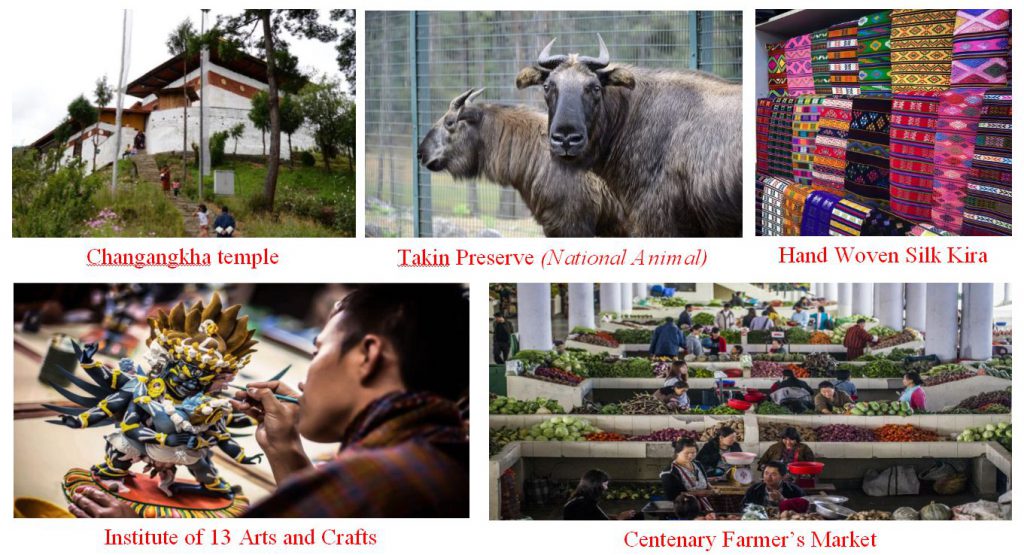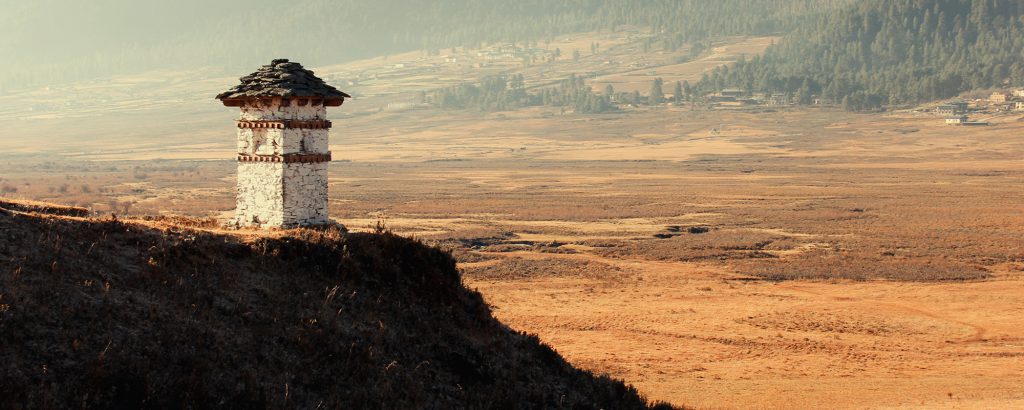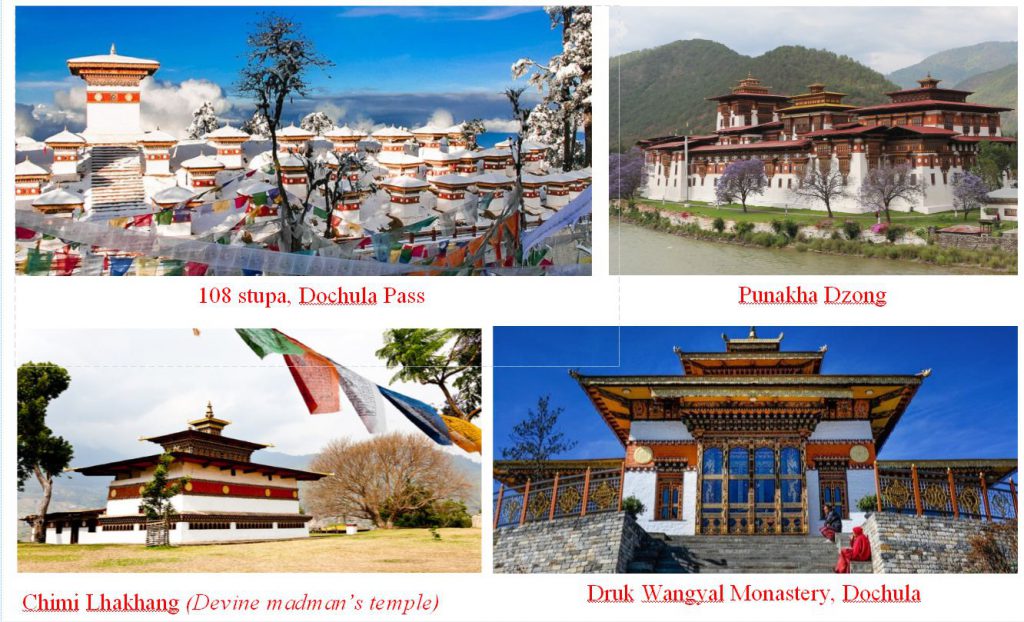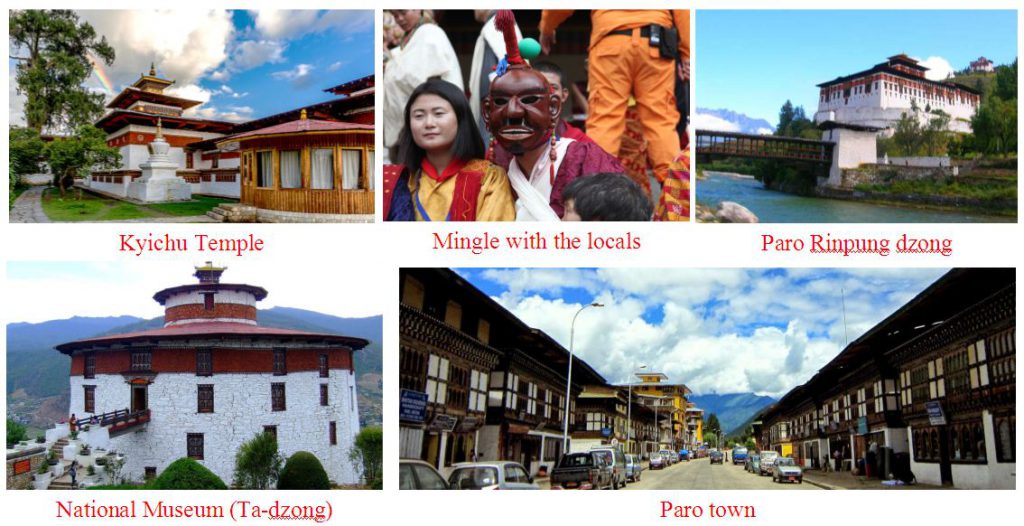
Durations: 10 days and 9 nights tour
Locations: Paro, Thimphu, Wangdue, Punakha, Phobjikha, Trongsa, Bumthang valley
Highlights: Restrictions on the numbers of tourists help to preserve the country’s natural assets and a way of life that has remained unchanged for millennium. Visitors will see monasteries perched at the tops of mountain peaks, ancient Buddhist art and sculpture, dense forests and
spectacular valleys.
Morning flight into Paro, Bhutan. On this flight, you can see breath taking views of the Great Himalayas. Upon arrival at Paro International Airport, you will be welcomed to the Kingdom by your guide. Lunch served in Paro. After lunch drive to Thimphu 2 – 3 hours.
The drive from Paro to Thimphu is spectacularly scenic one will be greeted by magnificent, monasteries and stupas in the valleys and mountain tops.
Overnight in hotel/resort at Thimphu

Full day of sightseeing. Some of the highlights of Thimphu include:

After breakfast drive to Gangtey and Phobjikha valley. Phobjikha valley has been declared as the first eco-tourism destination of Bhutan by the Royal Society for Protection of Nature (RSPN).
The valley falls under the Black Mountain Natural Park. Phobjikha valley is the winter home to rare and endangered black necked cranes (grus nigricllis), which migrate, in large flocks to Bhutan from Tibet & Sikang, Yunnan and Tonkin in eastern China. For centuries the cranes have captured the human imagination with their intelligence, poise, sociality, beauty and freedom, which have given rise to several myths, legends, folktales and songs.
In 1998 there were about 250 cranes and the numbers are increasing.
Although the cranes fly back to their summer homes in mid – late February, there may be a couple of birds that have not yet flown to their summer homes in Tibet and China.
There are lots of other wild animals in the surrounding valleys like wild boar, barking deer, Himalayan black bear, red fox, leopard and many species of birds.

Overnight in resort/hotel at Phobjikha

Today morning after breakfast we will visit the Nature Education centre, the carpet factory and the Sacred Gangtey Monastery, which dominates the valley.
After Lunch, continue your journey towards Central Bhutan. Check in for Overnight at Hotel.
Trongsa is the ancestral home of Bhutan’s Royal Family. Both the First and Second King ruled the Kingdom from this ancient seat. All the Kings of Bhutan has to become Trongsa Penlop (Honorary post of Governor) prior to being crowned as the Druk Gyalpo (King of Bhutan).
Trongsa Dzong (fort), one of the largest in the country was first built is 1648 and later enlarged many times. Because of being situated on a highly commanding position on the only connecting route between the eastern and western sectors (where trail actually runs through the Dzong), the Trongsa Penlop was able to control the whole of eastern region very effectively for many centuries.
Visit the ancient watch tower (Ta Dzong), which is situated just above the town.
After lunch, drive to Bumthang. The drive to Bumthang takes 2-3 hrs. Tales of the great Guru Padmasambhava dominates this holy valley. View the Jakar Dzong “The Castle of White Bird”.
A stop will be made on the way in the Chumey Valley where one can see girls weaving Yatha the traditional woollen material being used.
Overnight in hotel/resort at Bumthang.

Different from all the other valleys in Bhutan, Bumthang is very spacious and open ranging in altitude from 2,600m to 4,000m.
Bumthang is a heaven for hikers and trekkers, not to mention the numerous beautiful and important Buddhist monasteries and pilgrimage sites, making it the Cultural and Historic center of Bhutan.
One could spend months exploring this fascinating valley. Almost every little valley or hill has a background of interesting myths and legends about Kings, Buddhist masters and Serpents.
Bumthang is combined of four main valleys, Chumey, Tang, Ura and Choekhor (Jakar). Commonly known as Jakar valley where you can see a little bit of modern touch with Swiss Influences. Visits to the important cultural and historic sites in the special valley.
Today after breakfast we will drive to punakha valley with sightseeing en-route.
We will stop at certain places for tea/refreshments and drive slowly towards punakha valley.
If time permits we will visit the beautiful Punakha Dzong.
Built strategically at the junction of Pho Chhu and Mo Chhurivers in 1637, by Shabdrung Ngawang Namgyal to serve as the religious and administrative centre of the region, Punakha Dzong has played an important role in Bhutan’s history.
Overnight Punakha at Hotel

Punakha was the winter capital for over 300 years until the time of second King. Punakha Dzong, which dominates the whole area, was built in 1637 by Shabdrung Ngawang Namgyel, and established the central monastic body with 600 monks.
Today, Punakha is still the home for Je Khempo (Chief Abbot) and the central monastic body. Punakha Dzong is one of the most impressive Dzong in the Kingdom.
In the morning we will visit the Chimi Lhakhang. The Chimi Lhakhang, situated on a hillock in the centre of the valley, is dedicated to Lama Drukpa Kuenley, who in the late 15th century used humour, songs and outrageous behaviour to dramatize his teachings and due to this also known as “Divine Madman”.
This temple is also known as the temple of fertility. It is widely believed that couples who do not have children and wanting one, if they pray at this temple, they are usually blessed with a child very soon. It is about 30 minute walk across field from the road to the temple.In the afternoon drive to Paro.

Morning, hike up to the view point of “Taktsang”,popularly known as Tiger’s Nest Monastery.
The climb up to the viewpoint will take around 1 ½ hours and from there you will enjoy a spectacular view of the monastery clinging to the side of the cliff. Stop for refreshment at the View Point Cafeteria. Then walk further up to the monastery which will tak about 1 hour.
It is said that in the 8th century Guru Rinpoche flew on the back of a tigress from eastern Bhutan to this place and meditated in a cave here for 3 months. The principal Lhakhang (monastery) of the present monastic complex dates from 1692. Taktsang was damaged severely by fire in 1998 but has now been fully restored to its former glory. After visiting the monastery, walk back down to the road on the way stop for lunch at the view point cafeteria and then walk further down to the road point.
On the way, visit Kichu temple, one of the 108 temples built in the 7th century by the Tibetan Later visit King Songsten Gampo.
The story goes that a giant demon lay across the whole area of Tibet and the Himalayas and was preventing the spread of Buddhism. To overcome her, King Songtsen Gampo decided to build 108 temples, which would be placed on all the points of her body. Of these 108 temples, 12 were built in accordance with precise plans.
Thus, it happened that in about the year AD 638 the temple of Jokhang in Lhasa was built over the very heart of the demon.

Overnight in hotel/resort in Paro

After breakfast at the hotel, transfer to the airport for the departure flight. Tashi Delek.
• Deluxe rooms on twin sharing basis.
• Meals (Breakfast; Lunch; Dinner, Tea/Coffee with snacks as and when required)
• Accommodation in the best 3-4 star Resorts/hotels in Bhutan.
• Brand new Bus, SUVs’ (not exceeding 4-5 years)
• 1 complimentary Bhutan air ticket if group exceeds 17 Pax
• Tea, coffee and snacks during the long drive and tour.
• Complimentary 1 Hour cultural program and farewell dinner for 8 plus pax.
• All Trekking Equipments (2 men sleeping tents, Kitchen Tents, Dining tents, Toilet Tents, Cooking Utensils etc.
• Trekking Guide and trekking cook along with supporting staffs
• Medical Facilities on free of cost (consulting doctors & medicine)
• Mineral water on long trips both on trek and cultural tours
• Museum fees and other special entry fees.
• A sustainable tourism Royalty of $65. This Royalty goes towards free education, free healthcare, poverty alleviation, along with the building of infrastructure.
• Airfare
• Laundry/Drinks / Telephone calls and any personal expenses.
• Travel Insurance (Recommended but not available in Bhutan)
• Excess baggage charges.
• Single room supplement USD$40 per night.
• Tips and Gratuities